Page 274 of 416
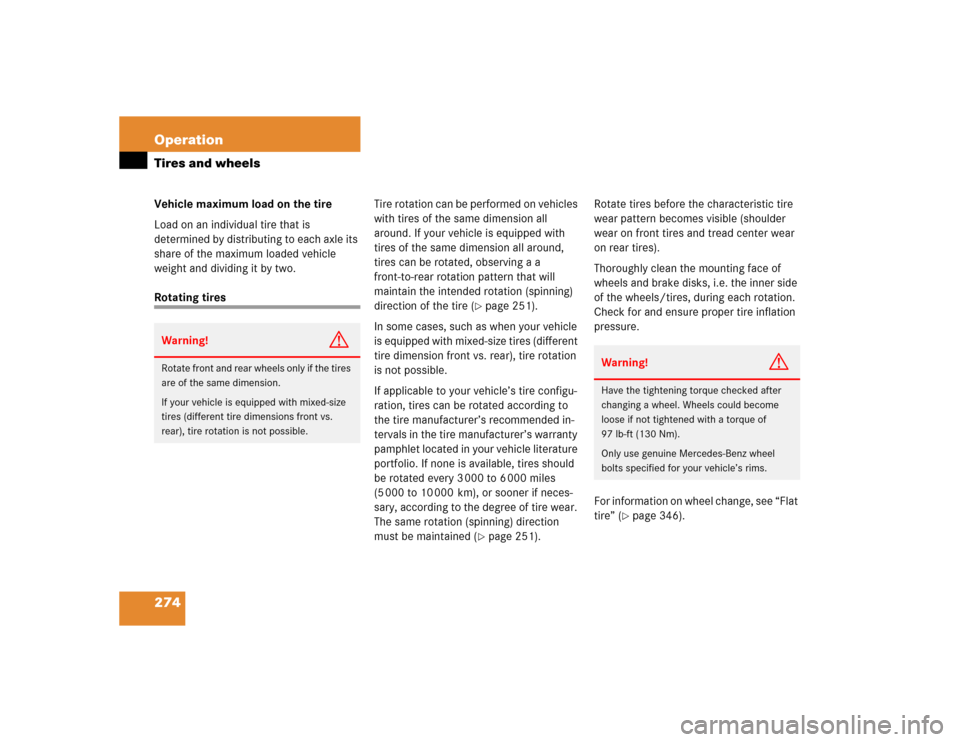
274 OperationTires and wheelsVehicle maximum load on the tire
Load on an individual tire that is
determined by distributing to each axle its
share of the maximum loaded vehicle
weight and dividing it by two.Rotating tiresTire rotation can be performed on vehicles
with tires of the same dimension all
around. If your vehicle is equipped with
tires of the same dimension all around,
tires can be rotated, observing a a
front-to-rear rotation pattern that will
maintain the intended rotation (spinning)
direction of the tire (
�page 251).
In some cases, such as when your vehicle
is equipped with mixed-size tires (different
tire dimension front vs. rear), tire rotation
is not possible.
If applicable to your vehicle’s tire configu-
ration, tires can be rotated according to
the tire manufacturer’s recommended in-
tervals in the tire manufacturer’s warranty
pamphlet located in your vehicle literature
portfolio. If none is available, tires should
be rotated every 3 000 to 6 000 miles
(5 000 to 10 000 km), or sooner if neces-
sary, according to the degree of tire wear.
The same rotation (spinning) direction
must be maintained (�page 251). Rotate tires before the characteristic tire
wear pattern becomes visible (shoulder
wear on front tires and tread center wear
on rear tires).
Thoroughly clean the mounting face of
wheels and brake disks, i.e. the inner side
of the wheels/tires, during each rotation.
Check for and ensure proper tire inflation
pressure.
For information on wheel change, see “Flat
tire” (
�page 346).
Warning!
G
Rotate front and rear wheels only if the tires
are of the same dimension.
If your vehicle is equipped with mixed-size
tires (different tire dimensions front vs.
rear), tire rotation is not possible.
Warning!
G
Have the tightening torque checked after
changing a wheel. Wheels could become
loose if not tightened with a torque of
97 lb-ft (130 Nm).
Only use genuine Mercedes-Benz wheel
bolts specified for your vehicle’s rims.
Page 280 of 416
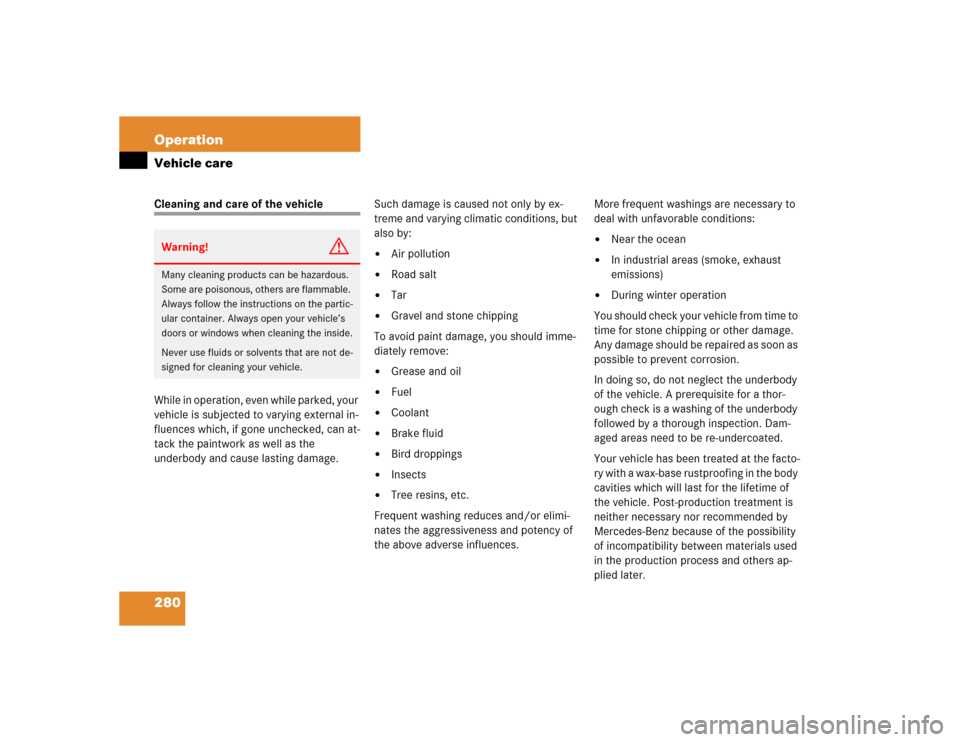
280 OperationVehicle careCleaning and care of the vehicle
While in operation, even while parked, your
vehicle is subjected to varying external in-
fluences which, if gone unchecked, can at-
tack the paintwork as well as the
underbody and cause lasting damage.Such damage is caused not only by ex-
treme and varying climatic conditions, but
also by:
�
Air pollution
�
Road salt
�
Tar
�
Gravel and stone chipping
To avoid paint damage, you should imme-
diately remove:
�
Grease and oil
�
Fuel
�
Coolant
�
Brake fluid
�
Bird droppings
�
Insects
�
Tree resins, etc.
Frequent washing reduces and/or elimi-
nates the aggressiveness and potency of
the above adverse influences.More frequent washings are necessary to
deal with unfavorable conditions:
�
Near the ocean
�
In industrial areas (smoke, exhaust
emissions)
�
During winter operation
You should check your vehicle from time to
time for stone chipping or other damage.
Any damage should be repaired as soon as
possible to prevent corrosion.
In doing so, do not neglect the underbody
of the vehicle. A prerequisite for a thor-
ough check is a washing of the underbody
followed by a thorough inspection. Dam-
aged areas need to be re-undercoated.
Your vehicle has been treated at the facto-
ry with a wax-base rustproofing in the body
cavities which will last for the lifetime of
the vehicle. Post-production treatment is
neither necessary nor recommended by
Mercedes-Benz because of the possibility
of incompatibility between materials used
in the production process and others ap-
plied later.
Warning!
G
Many cleaning products can be hazardous.
Some are poisonous, others are flammable.
Always follow the instructions on the partic-
ular container. Always open your vehicle’s
doors or windows when cleaning the inside.
Never use fluids or solvents that are not de-
signed for cleaning your vehicle.
Page 288 of 416
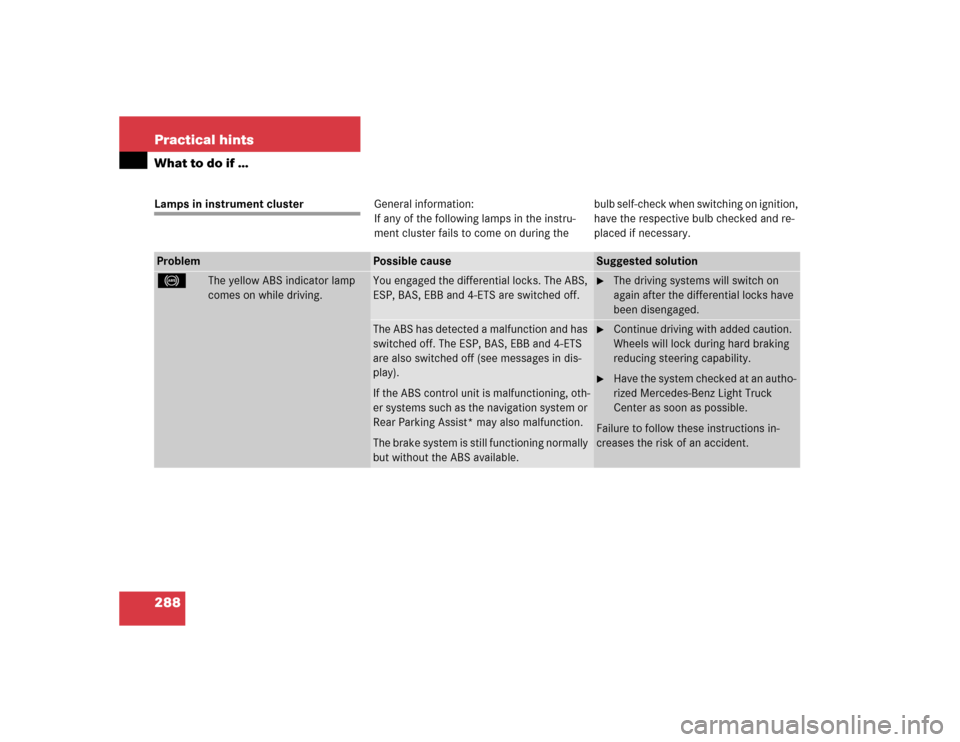
288 Practical hintsWhat to do if …Lamps in instrument clusterGeneral information:
If any of the following lamps in the instru-
ment cluster fails to come on during thebulb self-check when switching on ignition,
have the respective bulb checked and re-
placed if necessary.Problem
Possible cause
Suggested solution
-
The yellow ABS indicator lamp
comes on while driving.
You engaged the differential locks. The ABS,
ESP, BAS, EBB and 4-ETS are switched off.
�
The driving systems will switch on
again after the differential locks have
been disengaged.
The ABS has detected a malfunction and has
switched off. The ESP, BAS, EBB and 4-ETS
are also switched off (see messages in dis-
play).
If the ABS control unit is malfunctioning, oth-
er systems such as the navigation system or
Rear Parking Assist* may also malfunction.
The brake system is still functioning normally
but without the ABS available.
�
Continue driving with added caution.
Wheels will lock during hard braking
reducing steering capability.
�
Have the system checked at an autho-
rized Mercedes-Benz Light Truck
Center as soon as possible.
Failure to follow these instructions in-
creases the risk of an accident.
Page 290 of 416

290 Practical hintsWhat to do if …Problem
Possible cause
Suggested solution
;
(USA only)
3
(Canada only)The red brake warning lamp
comes on while driving and you
hear a warning sound.
You are driving with the parking brake set.
�
Release the parking brake
(�page 50).
�
Also note the messages in the multi-
function display (
�page 296).
The red brake warning lamp
comes on while driving.
There is insufficient brake fluid in the reser-
voir.
�
Risk of accident! Carefully stop the
vehicle and notify an authorized
Mercedes-Benz Light Truck Center.
Do not add brake fluid! This will not
solve the problem.
�
Also note the messages in the multi-
function display (
�page 296).
Warning!
G
Driving with the brake warning lamp illumi-
nated can result in an accident. Have your
brake system checked immediately if the
brake warning lamp stays on.
Do not add brake fluid before checking the
brake system. Overfilling the brake fluid res-
ervoir can result in spilling brake fluid on hot
engine parts and the brake fluid catching
fire. You could be seriously burned.
!If you find that the brake fluid in the
brake fluid reservoir has fallen to the
minimum mark or below, have the
brake system checked for brake pad
thickness and leaks.
Page 291 of 416
291 Practical hints
What to do if …
Problem
Possible cause
Suggested solution
;
(USA only)
3
(Canada only)
-
The red brake warning lamp and
the yellow ABS indicator lamp
come on when the engine is run-
ning and you hear a warning
sound for approximately five sec-
onds.
The EBB has detected a malfunction and has
switched off. You should be prepared for your
vehicle to perform differently than normal
when braking.
�
Continue driving with added caution.
�
Have the system checked at an autho-
rized Mercedes-Benz Light Truck
Center as soon as possible.
�
Also note the messages in the multi-
function display (
�page 296).
Failure to follow these instructions in-
creases the risk of accidents.
Page 298 of 416
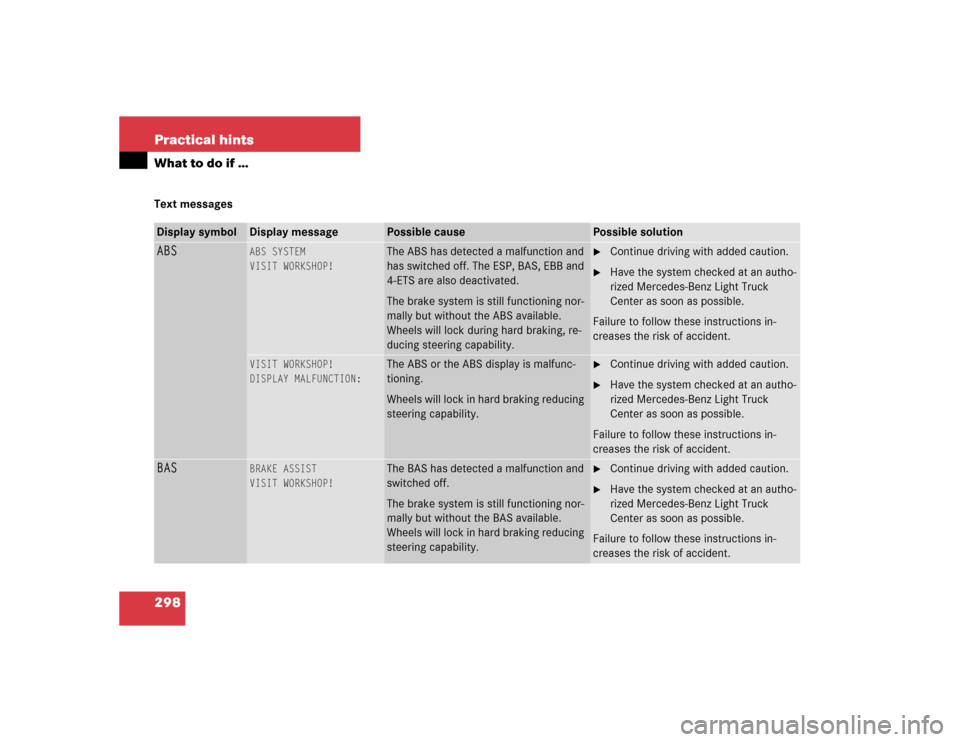
298 Practical hintsWhat to do if …Text messagesDisplay symbol
Display message
Possible cause
Possible solution
ABS
ABS SYSTEM
VISIT WORKSHOP!
The ABS has detected a malfunction and
has switched off. The ESP, BAS, EBB and
4-ETS are also deactivated.
The brake system is still functioning nor-
mally but without the ABS available.
Wheels will lock during hard braking, re-
ducing steering capability.
�
Continue driving with added caution.
�
Have the system checked at an autho-
rized Mercedes-Benz Light Truck
Center as soon as possible.
Failure to follow these instructions in-
creases the risk of accident.
VISIT WORKSHOP!
DISPLAY MALFUNCTION:
The ABS or the ABS display is malfunc-
tioning.
Wheels will lock in hard braking reducing
steering capability.
�
Continue driving with added caution.
�
Have the system checked at an autho-
rized Mercedes-Benz Light Truck
Center as soon as possible.
Failure to follow these instructions in-
creases the risk of accident.
BAS
BRAKE ASSIST
VISIT WORKSHOP!
The BAS has detected a malfunction and
switched off.
The brake system is still functioning nor-
mally but without the BAS available.
Wheels will lock in hard braking reducing
steering capability.
�
Continue driving with added caution.
�
Have the system checked at an autho-
rized Mercedes-Benz Light Truck
Center as soon as possible.
Failure to follow these instructions in-
creases the risk of accident.
Page 301 of 416
301 Practical hints
What to do if …
Display
Display message
Possible cause
Possible solution
ESP
ESP
VISIT WORKSHOP!
The ESP is switched off due to a malfunc-
tion or an interruption in the power sup-
ply.
The brake system is still functioning nor-
mally but without ESP, ABS and BAS avail-
able.
If in addition the ABS is malfunctioning,
only partial engine output will be avail-
able.
�
Continue driving with added caution.
�
Have the system checked at an autho-
rized Mercedes-Benz Light Truck
Center as soon as possible.
Failure to follow these instructions in-
creases the risk of accident.
Page 303 of 416
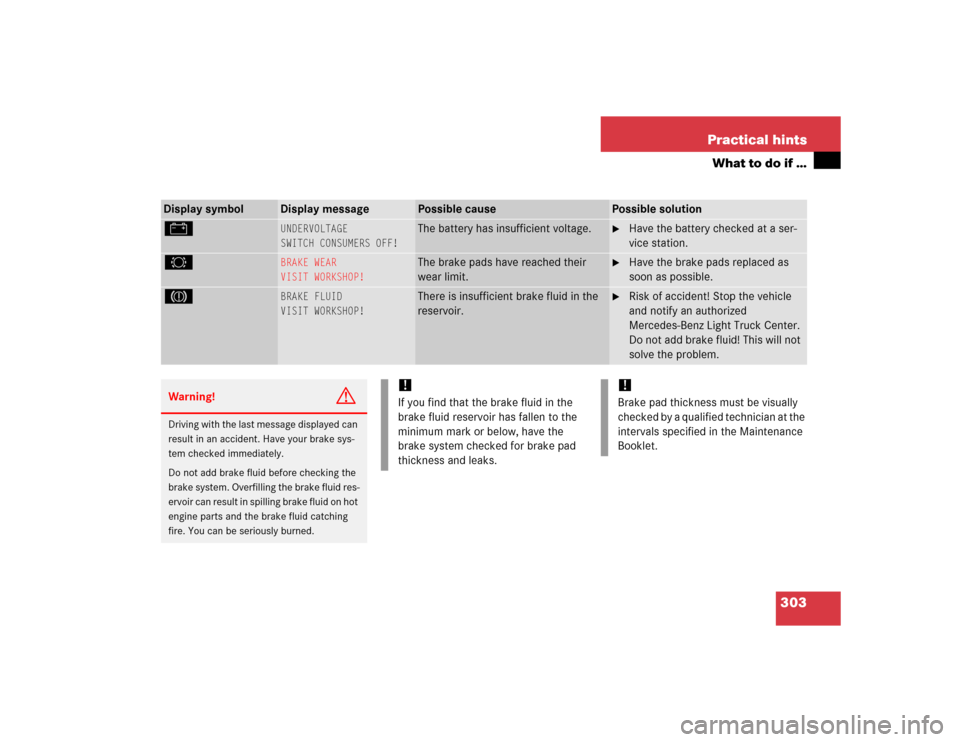
303 Practical hints
What to do if …
Display symbol
Display message
Possible cause
Possible solution
#
UNDERVOLTAGE
SWITCH CONSUMERS OFF!
The battery has insufficient voltage.
�
Have the battery checked at a ser-
vice station.
2
BRAKE WEAR
VISIT WORKSHOP!
The brake pads have reached their
wear limit.
�
Have the brake pads replaced as
soon as possible.
3
BRAKE FLUID
VISIT WORKSHOP!
There is insufficient brake fluid in the
reservoir.
�
Risk of accident! Stop the vehicle
and notify an authorized
Mercedes-Benz Light Truck Center.
Do not add brake fluid! This will not
solve the problem.
Warning!
G
Driving with the last message displayed can
result in an accident. Have your brake sys-
tem checked immediately.
Do not add brake fluid before checking the
brake system. Overfilling the brake fluid res-
ervoir can result in spilling brake fluid on hot
engine parts and the brake fluid catching
fire. You can be seriously burned.
!If you find that the brake fluid in the
brake fluid reservoir has fallen to the
minimum mark or below, have the
brake system checked for brake pad
thickness and leaks.
!Brake pad thickness must be visually
checked by a qualified technician at the
intervals specified in the Maintenance
Booklet.